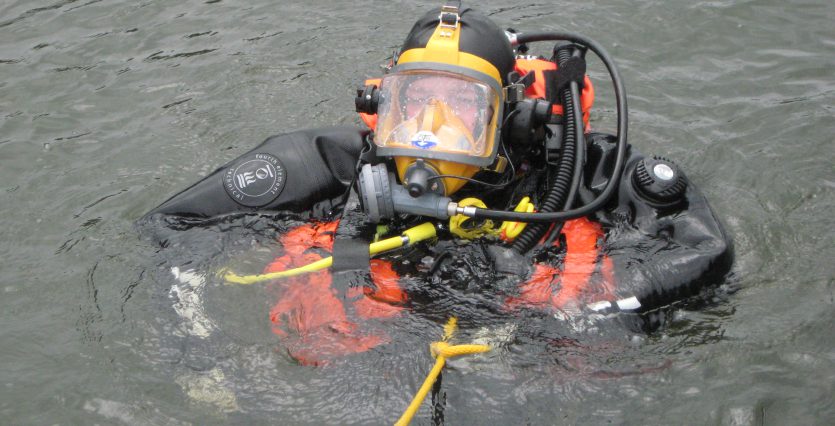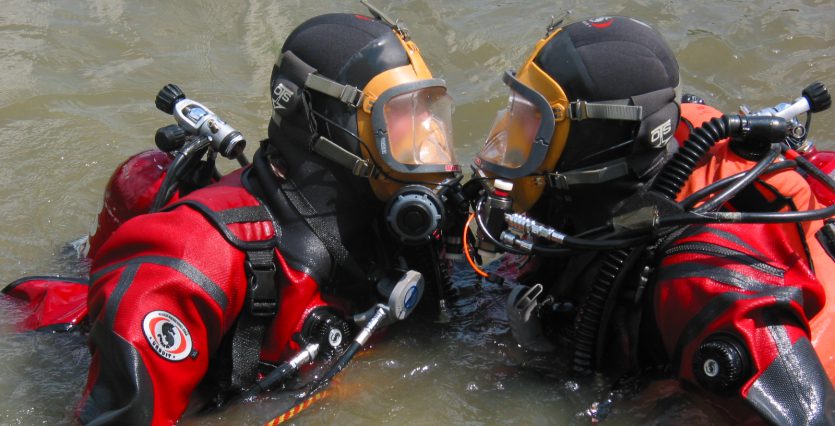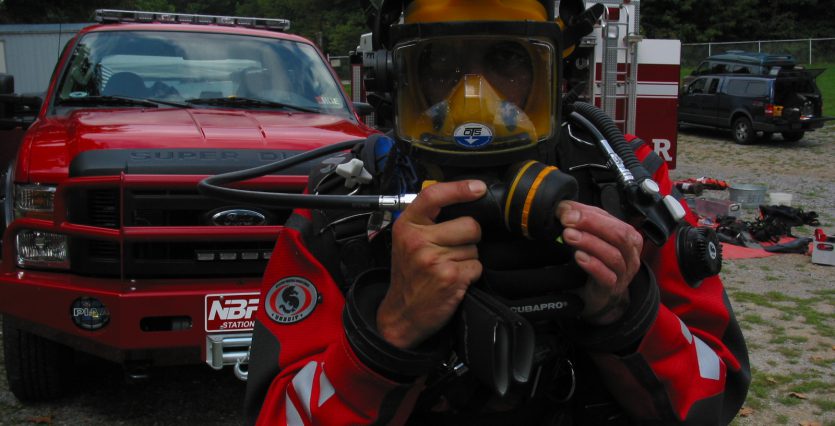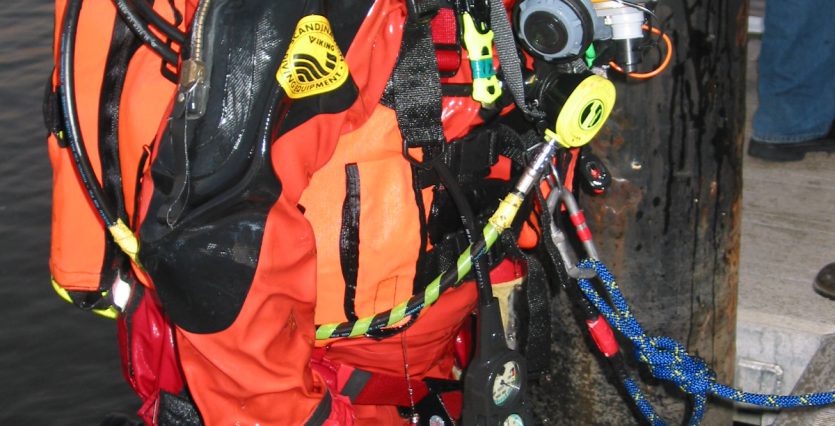It was just past 8 o’clock on a typical morning in late November 1948. About a dozen people were riding Stockholm Tramways’ electric trolley (also known as an overhead-wire bus) on their way to work. World War II had ended a few years earlier, and life was returning to normal. The morning commute did not stand out in any particular way until the crash. While crossing a bridge on its way to Stora Essingen, the trolley was suddenly struck by a truck. The trolley careened out of control, crashed through the rail on the side of the bridge, and for a few tense moments teetered nearly 15 meters (50 feet) above the icy water below. Then, without warning, the bus and its 12 occupants plummeted into the water. There was one witness on the bridge who saw this tragic scene unfold. The other witness was Börje Holm. He was the only surviving passenger aboard the trolley, which sank to the bottom, 17 meters (55 feet) below the surface.
Imagine the helpless Stockholm firemen who arrived at the scene, unsure whether there were still people alive, possibly trapped on the bottom and breathing from an air pocket in the bus. At the time, all the fire department had available were hard hat divers, and by the time they arrived on the scene an hour later, it was for the purpose of body recovery, not rescue. While this incident and the resulting loss of life was tragic, it started a chain of events that would lead to the development of tools, teams, and training that would save countless lives and give closure to families in the years to come.

The Stockholm Fire Department contacted a Swedish company, Aktiebolaget Gas Accumulator (AGA), for assistance in developing scuba gear that could be deployed quickly for emergency responders. Fortuitously, AGA was working on a scuba unit specifically designed for rapid-response divers. It had back-mounted tanks and the world’s first face-mask-mounted single-hose regulator. In other words, AGA had invented the first full face mask for public safety divers. This new diving tool would eventually become widely known as the AGA mask. Over the years, the AGA company became AGA Spiro, and then the diving products division separated and became known as Interspiro.
The name “AGA mask” is sometimes used interchangeably with “full face mask,” as “Kleenex” is used for “tissues.” While the actual AGA mask holds a prominent place in diving equipment history, its modern replacement is Interspiro’s DIVATOR MK II mask, but the MK II is not your father’s Oldsmobile. In addition to name changes, it’s experienced many engineering improvements over the decades.
While Interspiro may have years of experience over its competitors, Ocean Technology Systems (OTS) is another leading manufacturer of today’s high-tech masks. Both companies innovate different products that help today’s public safety and military dive teams get their job done more safely and efficiently than ever before. Many public safety dive teams in the U.S. use either the MK II or OTS’ Guardian mask. That’s not to say others aren’t getting into the game. Ocean Reef, Hollis, and Scubapro make full-face masks for public safety divers as well, for a growing audience of recreational divers. There are also masks made by Kirby Morgan and Dräger, which lean more toward the light commercial work category.
The two main reasons public safety and military divers prefer full face masks over traditional scuba masks are protected from contaminants and communications. Since these kinds of divers are often operating in less than optimal water conditions, keeping contaminants off of their faces and out of their noses and mouths is crucial. In addition, full face masks allow the integration of communications systems, vital tools that help get the job done safely and efficiently. In the recreational use of full face masks, communications are also a big draw.
So with several time-tested models out there and more to come, how can you, the NAUI diving professional, better talk to your students and customers about full face masks? First of all, if you’re considering diving one yourself or selling them to your clients, you’d be best served by taking a NAUI Full Face Mask Instructor Specified Specialty course, but at a minimum, you’ll find the following information to be of service.
Things to Know About Full Face Masks
Fit and Proper Adjustment
One of the most important things to learn about full face masks is proper fit and adjustment. Unlike with regular dive masks, the skirts of full face masks must be designed to fit a wider range of faces without leaking. If the mask is adjusted properly, it will more than likely fit well and make a complete seal. The harness that holds the full face mask to the diver’s head is called the spider. It typically has five straps coming off it, one at the top of the head and two sets at the middle and bottom of the head.
When a diver dons the full face mask, the most important thing is to make sure the mask is parallel to the face. The best way to do this is to put the harness on the back of the head first, hold it in place, and then pull the mask down into place. Once the mask is in place, the middle straps are snugged up (but don’t overtighten) to get the proper fit, with gentle and equal pressure on the mask at the top and bottom. Next, the slack in the bottom straps is gently taken up by pulling the straps straight back, not out to the sides. Finally, the strap at the top of the head is tightened. If the mask is not adjusted properly, the diver runs the risk of jaw fatigue, discomfort and a weak seal that could allow contaminants to enter the mask. With the mask adjusted properly, the diver should be able to wear it comfortably for hours.
Ear Clearing
On models such as the MK II and the Guardian, there is a nose block, a rubber pad that sits beneath the diver’s nose in the mask in the oral/nasal cup. Gentle pressure placed on the right spot on the front of the mask will push the block up high enough to block the nose and allow the diver to equalize. If the mask isn’t adjusted properly, this maneuver can be nearly impossible. On other masks, like Scubapro masks or the OTS Spectrum, the diver’s nose is more accessible, and divers can equalize as if using a standard scuba mask.
Mask Clearing
Since a full face mask is an oral/nasal mask, clearing it can be different from clearing a standard scuba mask. Many bigger full face masks have a purge valve at the bottom of the mask, so attempting to clear the mask of water as a diver normally would, by putting pressure at the top of the mask and tilting one’s head back while exhaling, could actually worsen the problem. The proper technique involves tilting the head forward and gently exhaling out the nose (or gently using the purge button on the regulator). This will
efficiently remove the water from the mask. Without proper instruction, there’s a good likelihood your customers will return unhappy with their new gear, thinking their inability to clear water from the mask resulted from a problem with the mask rather than their technique.
Air Consumption
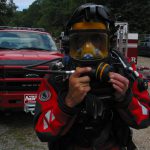
Divers new to full-face masks will typically consume 15 percent more air than they would on regular scuba. Even experienced full face mask divers will still consume between 5 and 10 percent more gas. This means they have to plan accordingly to return to the surface with their target amount still in reserve.
Maintenance
Proper maintenance of a full face mask is important. More often than not, public safety divers are diving in environments where there may be contaminants in the water. Some full-face masks have skirts made of natural rubber, which is better than silicone at resisting chemicals like gasoline; a silicone skirt will actually absorb some of these contaminants. That said, proper cleaning of either kind of mask skirt is important. A thorough soaking for a minimum of 15 minutes in an approved cleaning solution, followed by the vigorous swishing of the mask, will help remove contaminants from the skirt. Close attention must be paid to all of the folds in the mask skirt, where contaminants, mud, and mildew can hide. Natural rubber can dry out over time, and exposure to fluorescent lights or sunlight can damage all kinds of mask skirts, so after the mask is thoroughly dried, it should be stored in a cool, dry, dark place, such as a hard case.
Features to Look For
Contamination Prevention
As previously mentioned, public safety and military divers are frequently diving in areas that might have contaminants, such as spilled gasoline in the water, contaminants in the sediment at the bottom, etc. The material of the mask can make a difference, depending on the types of environments a diver plans to enter. Natural rubber is typically recommended for more highly contaminated environments, while silicone skirts are generally softer and more comfortable, but not as resistant to contaminants.
Another means of contamination prevention is positive pressure within the mask. Interspiro’s MK II offers a positive pressure option. Simply put, it keeps a positive pressure of air inside the mask at all times; if leakage were to occur, the slightly greater pressure inside the mask would prevent contaminants from finding their way into the mask.
Another recommendation for diving in contaminated environments is to wear a drysuit with an attached dry hood that has a slick rubber outer skirt around the diver’s face (no seams), on which the full face mask can properly seal. The drysuit should also have attached dry gloves. This type of exposure protection minimizes the possibility of contaminants touching the diver’s skin.
Regulator and Air Supply
Some masks, like the MK II or the Guardian, come with second-stage regulators that are specially designed for the masks. In the case of the MK II, the regulator is mounted to the mask. The Guardian’s regulator, on the other hand, can be detached at the push of a button. Many other models on the market today will allow a standard second-stage regulator to be attached. If used in cold water, the regulator should be rated for ice diving.
Interspiro also offers a lightweight surface-supplied system for public safety divers, with air delivered through the lifeline, as well as high-pressure 300-bar (4,350 psi) carbon-fiber cylinders that are approved by the U.S. Department of Transportation. They’re easy to transport to the scene due to their lightweight. The air is delivered to the diver with a dual-purpose tether/umbilical that can also be rigged with hard-wired communications. The air supply can be monitored by the surface personnel, and cylinders can be “hot-swapped” during the dive, allowing the diver to stay down longer if necessary.
Communications
Because divers wearing full-face masks don’t have regulators in their mouths, they’re free to talk if needed. In public safety diving, verbal communication with surface personnel (and sometimes between divers) adds a level of safety for the divers and makes their work proceed more efficiently. Communications systems come in two varieties, wired and wireless. Since most public safety divers work with a tether, adding hard-wired communications is not too difficult, but for those working in environments like a bayou, where it’s easy to become entangled, or for recreational divers, the wireless option may be better, though more limited in range. OTS is the leader in underwater communications. In fact, the company frequently works with other manufacturers to help integrate communications into full face mask product lines.
Ambient Breathing
As soon as the full face mask is on the diver’s face, the diver begins consuming air, so many models have what is called a “hatch” or “ambient breathing valve,” which allows the diver at the surface to don the mask but continue to breathe air from outside the system, saving precious air supply for underwater.
Accessories
Some of today’s full face masks are available with optional rails. These attachment points at the sides of the mask can host a variety of add-ons, like LED lights, welding shields or cameras. Another nice option made by Interspiro is a heads-up-display low-air warning light. Many public safety divers work in blackout conditions, and it’s possible that they may not be able to read their gauges even at very close range. Interspiro’s solution is an LED that attaches to the corner of the mask; when the air supply hits a preset point, the light begins to flash, signaling to the diver that it’s time to wrap up. Some use a low-tech solution by filling a sealable plastic bag with clean water and a chemical light stick, duct-taping that to the front of the gauge, and simply pressing it to the faceplate to read the pressure.
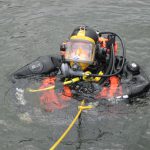
Are Full Face Masks In Your Future?
With full face masks being adopted rapidly by public safety divers around the U.S. and the world, it’s a good idea to get familiar with them. In addition, there are more and more recreational divers taking to the water with these masks. It certainly doesn’t hurt for you and your dive center to stay ahead of the curve and offer training as well as equipment to divers in your area.
When creating an article such as this, the opinions of experts are required to create a full and varied picture of the equipment and its proper use. In the case of full-face masks, we consulted a number of experts. For the manufacturers’ perspectives, both Bengt Kjellberg of Insterspiro and Andy Nelson of OTS were extremely generous with their time and expertise. Bengt was also instrumental in researching the tragic events in Stockholm that got the ball rolling on the use of full-face masks in public safety diving. Butch Hendrick of Team Lifeguard Systems provided us with the expertise used to create the section of the article entitled ‘Things To Know About Full Face Masks.’ Butch is also consulting with NAUI on the creation of full face mask training support materials. In addition, Lieutenant Steve Brown of the Cambridge Fire Department, Cambridge, MA, helped clarify how his water rescue team deploys full face masks and the specific equipment they use with pros and cons to each. We extend a big thanks to these dedicated professionals that develop, train and deploy full face masks to the benefit of the public around the world.


